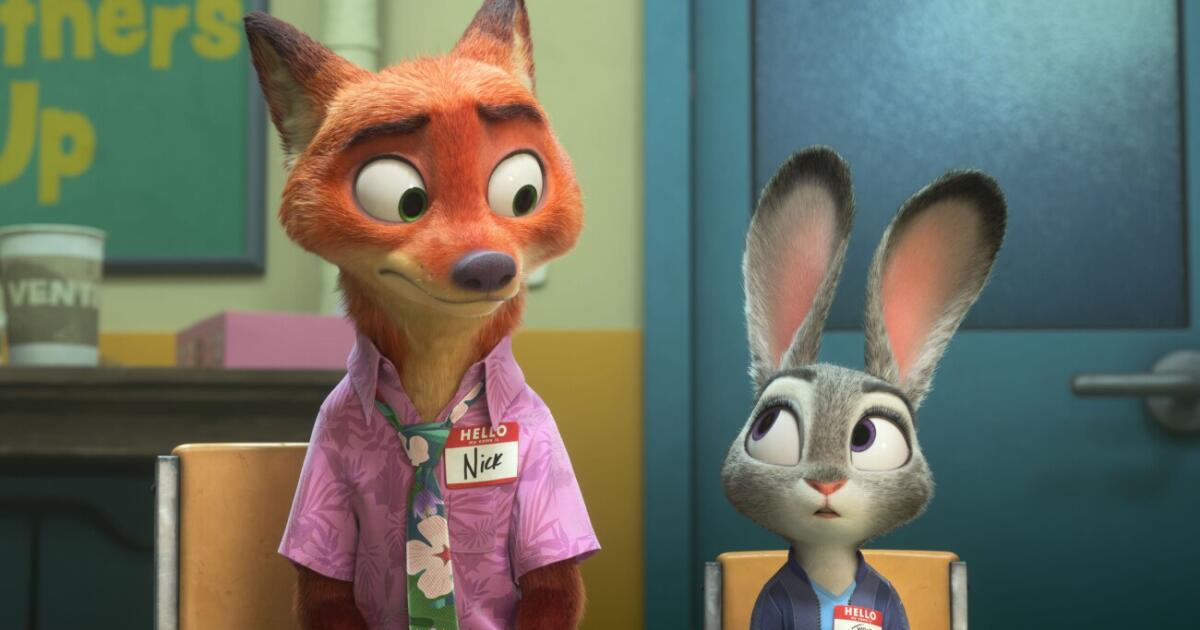‘Zootopia 2’ review: Disney’s most effective animated sequel is punchier
Disney’s latest animated film, “Zootopia 2,” a sequel to its 2016 box-office juggernaut, isn’t exactly an adult political drama, though the stakes certainly feel grimmer. Members of Zootopia’s elite plan to expand their territory by displacing certain indigenous animals from an area they want to claim for themselves. And they will do so without pushback by convincing the rest of the population that their uprooted neighbors are dangerous. Any attempt by the victims of this injustice to reclaim their homeland and their dignity will be deemed a violent attack. In turn, anyone who sides with their cause will be labeled a criminal enabler, a disloyal pariah.
Meanwhile, tensions flare in law enforcement as pawtners Nick Wilde and Judy Hopps (voiced by Jason Bateman and Ginnifer Goodwin) — who in the previous film saved Zootopia from a power-hungry wolf in sheep’s clothing — have to prove their compatibility after their recklessness lands them in hot water with Chief Bogo (Idris Elba). Could their personalities be too disparate for them to make a dream team? Judy values justice above all things, while Nick prioritizes survival and comfort. In truth, the tie-wearing fox only became a cop because of his fondness for Judy, not out of a sense of dutiful conviction.
That push-and-pull tests the strength of their bond as they visit previously unseen areas of Zootopia, including a visit to the Marsh Market, where exiles live. These adventures occur as they search for Gary De’Snake (Ke Huy Quan), a fanny-pack-strapped viper, and Pawbert Lynxley (Andy Samberg), the socially conscious son of a wealthy family. They’re on a quest to find evidence that would clear the reputations of reptiles in Zootopia, all of whom have been forced to exist on the outskirts for decades.
Writer Jared Bush, who also co-directs with Byron Howard (both return from the first “Zootopia”), leans into Quan’s personal history as an immigrant whose family had to escape Vietnam to render Gary a resilient survivor with a noble soul. Leave it to Disney to make a giant snake look disarmingly adorable and to Quan to match that energy with his warm vocal performance. On top of the new characters, Judy and Nick’s emotional arc is adorned with cameos from fan-favorite minor players from the original (Flash, the sloth; Mr. Big, the shrew). The loaded narrative robs the picture of more time with Gary and Pawbert, even if Bush finds plot-effective ways to feature the supporting mammals.
Like its predecessor, “Zootopia 2” impresses visually, especially given the breadth of characters and environments it immerses the audience in. In the faces of new characters like the anxious Pawbert and friendly Gary, one can best appreciate the level of nuanced expressiveness that Disney’s animators, working at the highest level of 3-D CG technique, can achieve.
After several haphazard attempts with the “Frozen” and “Moana” franchises, “Zootopia 2” can take the title as Disney’s most effective animated sequel yet. In most regards, the formula that propelled the first one to hit status remains unchanged: an encyclopedia of animal puns, an upbeat tune by Shakira and a twist villain (in this case, an Elon Musk type desperate for approval that all the money in the world can’t buy). And yet, “Zootopia 2” arrives as an expansion with a punchier, more focused approach to its mature ideas. This is a movie where the antagonists are willing to kill for their nefarious goals, and where the heroes are willing to die in order to uphold what’s right.
The more one reads into the movie’s timeliness, though, the more obvious it becomes that there’s a dissonance between the artists making an animated feature such as this one and the company’s leadership, which continues to push artificial intelligence and capitulate to those who bemoan “wokeness.” Those people might certainly find “Zootopia 2” rather woke indeed. (Who knows, maybe in the next installment Judy and Nick will question their role in perpetuating the police state.) In our bizarro world, the “Zootopia” franchise serves as a vehicle for thought-provoking subjects disseminated by way of colorful anthropomorphic animals.
‘Zootopia 2’
Rated: PG, for action/violence and rude humor
Running time: 1 hour, 48 minutes
Playing: In wide release Wednesday, Nov. 26
